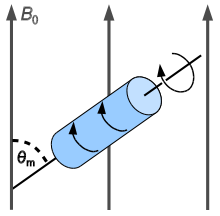- Magic angle spinning
-
In nuclear magnetic resonance, magic angle spinning (MAS) is a technique often used to perform experiments in solid-state NMR spectroscopy.[1][2]
By spinning the sample (usually at a frequency of 1 to 70 kHz) at the magic angle θm (ca. 54.74°, where cos2θm=1/3) with respect to the direction of the magnetic field, the normally broad lines become narrower, increasing the resolution for better identification and analysis of the spectrum.
In any condensed phase, a nuclear spin experiences a great number of interactions. The main three interactions (dipolar, chemical shift anisotropy, quadrupolar) often lead to very broad and featureless lines. However, these three interactions in solids are time-dependent and can be averaged by MAS. The nuclear dipole-dipole interaction, between magnetic moments of nuclei averages to zero only at the magic angle, θm . The chemical shift anisotropy, a nuclear-electron interaction, averages to a non-zero value. The quadrupolar interaction is only partially averaged by MAS leaving a residual secondary quadrupolar interaction. In liquids, e.g. a solution of an organic compound, most of these interactions will average out because of the rapid time-averaged molecular motion that occurs. This orientation averaging in solution is mimicked by MAS of a solid. This causes the signal to become much narrower, giving rise to the isotropic value (which is of interest for structural determination of solid materials and compounds) and spinning sidebands which occur at multiples of the spinning speed and can be used to determine the chemical shift anisotropy of the nuclei.
The physical spinning of the sample is achieved via an air turbine mechanism. These turbines (or rotors) come in a variety of diameters (outside diameter), from 2.0-15.0 mm, and are usually spun on air or nitrogen gas. The rotors are made from a number of different materials such as ceramics e.g. zirconia, silicon nitride or polymers such as poly(methyl methacrylate) (PMMA), polyoxymethylene (POM). The cylindrical rotors are axially symmetric about the axis of rotation. Samples are packed into the rotors and these are then sealed with a single or double end cap. These caps are made from number of different materials e.g. Kel-F, Vespel, zirconia or boron nitride depending on the application required.
Magic-angle spinning was first described in 1958 by Edward Raymond Andrew, A. Bradbury, and R. G. Eades[3] and independently in 1959 by I. J. Lowe.[4] The name "magic-angle spinning" was coined in 1960 by Cornelis J. Gorter at the AMPERE congress in Pisa.[1] Edward Raymond Andrew had numerous publications on the subject of MAS[5][6][7][8][9][10][11][12][13][14][15][16][17][18], including Knight shifts in metals[19][20]
References
- ^ a b Jacek W. Hennel, Jacek Klinowski (2005). "Magic Angle Spinning: A Historical Perspective". In Jacek Klinowski. New techniques in solid-state NMR. Springer. pp. 1–14. doi:10.1007/b98646. ISBN 3-540-22168-9. (New techniques in solid-state NMR at Google Books)
- ^ E. Raymond Andrew (2010). "Magic Angle Spinning". In Anne McDermott. Solid State NMR Studies of Biopolymers. John Wiley & Sons. pp. 83–97. ISBN 0-470-72122-7. (Solid State NMR Studies of Biopolymers at Google Books)
- ^ E. R. Andrew, A. Bradbury, R. G. Eades (1958). "Nuclear magnetic resonance spectra from a crystal rotated at high speed". Nature 182 (4650): 1659. Bibcode 1958Natur.182.1659A. doi:10.1038/1821659a0.
- ^ I. J. Lowe (1959). "Free Induction Decays of Rotating Solids". Phys. Rev. Lett 2 (7): 285–287. Bibcode 1959PhRvL...2..285L. doi:10.1103/PhysRevLett.2.285.
- ^ E.R. Andrew, Nuclear magnetic resonance spectra from a crystal rotated at high speed, Nature 182, 1659 (1958)
- ^ E.R. Andrew and R.A. Newing, The narrowing of nuclear magnetic resonance spectra by molecular rotation in solids, Proc. Phys. Soc. 72, 959 (1958)
- ^ E.R. Andrew, A. Bradbury and R.G. Eades, Removal of dipolar broadening of nuclear magnetic resonance spectra of solids by specimen rotation, Nature 183, 1802 (1959)
- ^ E.R. Andrew, Nuclear magnetic resonance in solids, Brit. J. Appl. Phys. 10, 431 (1959)
- ^ E.R. Andrew, A. Bradbury, R.G. Eades and G.J. Jenks, Fine structure of the nuclear magnetic resonance spectra of solids: chemical shift structure of the spectrum of vphosphorus pentachloride, Nature 188, 1103 (1960)
- ^ E.R. Andrew and R.G. Eades, Possibilities of high-resolution nuclear magnetic resonance spectra in crystals, Disc. Farad. Soc. 34, 38 (1962)
- ^ E.R. Andrew and V.T. Wynn, Solid-state P-31 magnetic resonance shifts and fine structure, Proc. Roy. Soc. 291A, 257 (1966)
- ^ E.R. Andrew, L.F. Farnell and T.D. Gledhill, Resolved spin multiplets in the NMR spectra of solids, Phys. Rev. Lett. 19, 6 (1967)
- ^ E.R. Andrew, M. Firth, A. Jasinski and P.K. Randall, NMR spin multiplets in solids resolved by high-speed rotation, Bull. Am. Phys. Soc. II 15, 257 (1970)
- ^ E.R. Andrew, The absence of chemical shift anisotropy in the multiple pulse NMR spectrum of a solid, Phys. Lett. 32A, 520 (1970)
- ^ E.R. Andrew and A. Jasinski, Nuclear magnetic resonance spectra of rapidly-rotated solids containing reorienting molecular groups II, Proc. 16th Congr. AMPÈRE, Bucharest, 1970, 1019 (1971)
- ^ E.R. Andrew, Magic angle spinning in solid state NMR spectroscopy, Phil. Trans. Roy. Soc. A299, 505 (1981)
- ^ E.R. Andrew, Nuclear magnetic resonance at high magnetic fields, Abstracts, Bull. Am. Phys. Soc. 36. 2753-2754 (1991)
- ^ E.R. Andrew, Spinning the spins: a lifetime of NMR. In: Encyclopaedia of NMR, ed. D.M. Grant and R.K. Harris, Wiley, Chichester, 180-187 (1996)
- ^ E.R. Andrew, J.L. Carolan and P.J. Randall, Measurement of the Ruderman-Kittel interaction for copper, Phys. Lett. 37A, 125 (1971)
- ^ E.R. Andrew, J.L. Carolan and P.J. Randall, Precise measurements of the Cu-63 and Cu-65 NMR chemical shifts in solid cuprous halides by the high-speed rotation method, Chem. Phys. Lett. 11, 298 (1971)
Categories:- Scientific techniques
- Nuclear magnetic resonance
Wikimedia Foundation. 2010.

